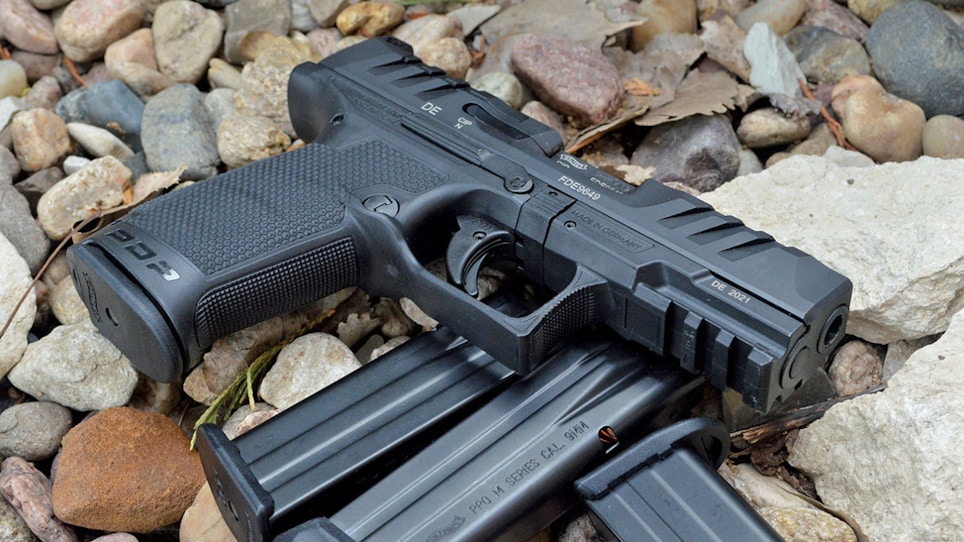Just over two decades ago, in 1997, Walther introduced the P99, which was widely regarded as a cutting-edge handgun design unlike anything else on the market. The comfortable ergonomics and modern design of the P99 directly influenced the 2011 release of the PPQ based on customer feedback. The draws to the design of the PPQ were amazing out-of-the-box customizable fit, comfort, match-grade accuracy, and a class-leading trigger in a field of striker-fired handguns. The PPQ was also packed with many out-of-the-box custom features that made it a great deal. Over the last few years, the expanded range of PPQ offerings included the PPQ M1 and M2 version and task-focused models such as the Q5, Q5 Match, Q4, Q4 Tac and Sub Compact. There were also the steel frame models and one-off, limited production, custom shop, premier-tier releases. As the company released one expanded PPQ-based model after another, Walther found that customers were craving the custom options that included red-dot optics mounts, the flexibility of longer barrel options, and an improved trigger — and the PDP represents the next evolution of the core line for Walther. The PPQ release was also another major milestone evolution celebrated by the industry and customers, with the PPQ ultimately maturing over the years into the newly released Walther PDP.
The PDP delivers an even better trigger, improved ergonomics, grips that reduce chafing, and red-dot ergonomics and mounting. The most interesting PDP feature is the complete modular flexibility to take any PDP frame and install it on any length barrel/slide combo. Customers have the flexibility to have a compact carry gun on the weekdays and a red-dot-equipped longer-barreled competition gun with the same compact frame — a transformation that could take just a few seconds. Notably, the new enhanced Performance Duty Trigger (PDT) is even better, with a shortened travel and more crisp break. The new PDT trigger is as good as most aftermarket match triggers — actually, customers will probably note that the trigger is freaky good for a defensive pistol.
Existing PPQ customers with a range bag full of magazines will be happy to hear the PDP Compact shares the same magazines. The PDP Full-Size frame offers a boost to new longer 18-round magazines grip-frame, which are backward compatible with PPQ and PDP Compact owners, but the shorter 15-round magazines obviously will not fit the longer grip.
Superterrain Serrations
The SuperTerrain Serrations are uniquely designed protruding serrations on the slide, allowing more assured engagement with the pistol. During the milling and manufacturing process, the serrations are left as the high point, with the slide surface being milled down instead of milling in the serrations. The net of this fatter-feeling slide is a much more positive feel to operating the action, however, because of it, the PDP’s fatter slide contour will not share the same holster as the PPQ models.
Performance Duty Texture
The Performance Duty Texture provides a new tetrahedron grip surface, which delivers an aggressive grip and a less abrasive feeling against the user’s skin or clothing. Walther performed extensive testing to ensure the new grip pattern worked even in the worst conditions.
Red-Dot Ergonomics
The RDS ergonomics on the Walther PDP are designed around making the switch to the popular RDS (red-dot sight) systems easier. For a lot of new RDS shooters, the natural point of aim is usually at the iron sight level, but with a bit more pinky pressure training, the sight falls into perfect alignment each time. Walther has put a lot of engineering into getting these nuanced ergonomics correct. The RDS ergonomics have been engineered to allow shooters to locate the red dot instantly when presenting, achieved by engineered pinky pressure. The PDP grip angle is designed for a natural aiming position, which complemented by and coupled with the innovative RDS ergonomics, allows for lightning-fast acquisition of the red dot.
Red-Dot Ready
All PDP models come optics-ready with a factory cover in place but without the typical case full of RDS adapters. Instead, once customers decide on an optic, they can log into waltherarms.com/optic-plate-request for one free adapter plate or purchase additional plates from Walther as needed.
Modularity
The PDP is the most modular and versatile pistol ever designed by Walther, with the ability to accept any slide length on any frame, even if it is not a factory offering. We started to see hints of this modularity with the PPQ’s optional Q5 Match M2 upper. The PDP openly scales that entire concept with two distinctly different frame sizes and eventually three different lengths of slides available to tailor this pistol for any needs. Walther obviously has plans to promote modularity long-term, which could even include future slide and frame redesigns. Currently the PDP Compact 4-inch, PDP Full 4-inch, and PDP Full 4.5-inch models are available, and hopefully, a longer slide competition model is coming as well. Our test model was based on the Compact with the 4-inch barrel, however, Walther noted that the plan is to offer many different options for customers to configure for their needs — one platform, many options.
Reality, Functionality and Testing
A lot of shooters will look at the PDP and see a warmed-over PPQ, just as some did with the P99-to-PPQ transition, however, the PDP features a set of big refinements and represents a step in a different direction. As a long-time PPQ owner and shooter, I’ve always thought the PPQ format had an appeal, with the sublime fit paired with the custom touches and upgraded features that require huge sums of money to achieve on other platforms. Walther carried those traits over into the PDP, and they have also addressed some annoyances for shooters. The grip is much easier on the skin and greatly reduces chafing while still remaining aggressive in the hand. The PPQ’s wedge-profile slide made concealment easier, but in some situations, it made manipulation difficult, and the PDP’s massive serrations address that issue without degrading concealability. The only miss I saw on the initial release was the plastic sights — they are good quality, however, metal sights will likely be my first upgrade. Historically, night sights became an option in the PPQ lineup about a year after the initial release.
The front strap finger grooves have been removed in favor of a flat checkered front strap, and the trigger travel and reset is now down about a third from .4-inch to .28-inch while still delivering about the same 5.6-pound pull weight. The PDP Compact was a little less snappy to shoot directly compared to my PPQ, which likely is due to about 3 extra ounces of weight and a marginally longer length and taller size than the original PPQ M2. I personally found the PDP a bit faster and easier to shoot.
Though it was a tough start historically for red-dots to achieve a tier of survivable reliability on handgun slides, we now have reliable red-dot optics that can survive the continual recoil on handguns. The later PPQ models like the Q4 Tac and Match models offered red-dot-ready slides, but with the PDP, every model includes red-dot sight compatibility — and Walther was able to keep the cost down by not including half a dozen adapters in the case. But it is the modularity that makes the PDP so interesting and opens up the platform broadly to many factory and aftermarket options like we have seen with other manufacturers.
Accuracy was marginally better than what I have historically experienced with the Stepped-Chamber PPQ models; it’s likely that accuracy improvement is due to the trigger improvements. Walthers have been very accurate competition-ready guns out of the box, and the PDP is no exception. As you might imagine, much of the testing was conducted with reloads and a limited amount of factory ammunition, however, notably, the PDP has enough striker energy to reliably set off small rifle primers on 9mm reloads. Walther has the next evolution that will easily carry it through the next decade.






